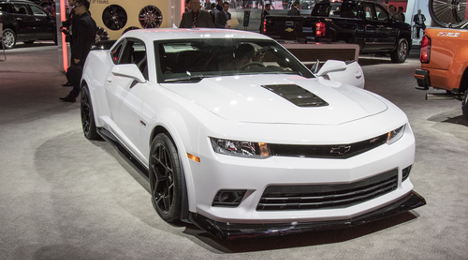At the close of the third quarter, our nation’s seven publicly traded dealer groups collectively averaged their 25th consecutive quarter of same-store used unit sales increases.
Cox Automotive’s chief economist Tom Webb, speaking during the Manheim Index Quarterly Conference Call on Friday, says a 26th is probable, but will be a challenge to achieve.
“Slide 14 shows the seven publicly trade dealership groups and it shows that they have had 25 consecutive quarters of same-store growth in used-units retailed,” Webb said, referring to slides accompanying his presentation. “Achieving the 26th quarter will be a little bit difficult because CarMax has already reported a 0.8-percent decline in their quarter, which ends in November.
“But I still think the 26th quarter will be achieved because CarMax was more focused on supporting gross than I believe that the others will be. Which, obviously, writes in the equation, that by extension, I expect the downward sloping lines in Slide 15 will also continue.”
And the latter slide, as you probably inferred, references the used-vehicle retail gross margin for the same publicly traded dealer groups. The gross margins for used sales for the public groups is currently trending to its lowest percentage in several years — a trend Webb says has two faces.
“Now, there are two ways of looking at that gross margin trend. One could just say it’s plain ugly, and it’s dangerous,” he said. “Or, you can argue that it’s just simply the case of a competitive industry passing on its efficiency savings to the consumer. Obviously the truth lies somewhere between the two.
“But more importantly, from my perspective, I do not believe that grosses should, and hopefully they won’t, go much lower. So that means don’t look for operating efficiencies at the retail level to continue to bail out the commercial consignors. The dealers have done more than their part,” Webb said.
He says dealership proficiencies have helped that margin decline due to the lowered costs of operation that result from such efficiencies.
“A lot of that reduction in gross, I wouldn’t say was ‘willingly’ given away, but because there were tremendous increases in operation efficiencies, other dealers were able to give it away,” Webb said. “The ability to keep achieving those operating efficiencies I think are a little bit limited going forward. And certainly the benefit of exceptional growth in the throughput has probably slowed it a little bit, too.”
For more takes on Webb’s analysis, including the used-car market’s current stretch of wholesale price stability, click here.
Happy New Year, everyone.
Before I speak to simulcast, I would like to take this opportunity to thank Bill Zadeits and his fabulous staff for an incredible and informative NRC 2015 and my panel members at the Executive Session, that each year step out of the box to address current items that are central to our understanding of the needs of our industry.
Regarding simulcast and the need for it to push down into older year, make and models, that process has been slow in coming even though the average age of vehicles on the road in this country is around 11.
Rarely do we get any data, as penetration volumes are reduced to percentages of growth and not to specific market segments, like rent-a-car, new off-lease, near-new or subprime.
In our NRC session, it was clear that costs for Internet uploads of older/subprime units were not only extensive and highly detailed oriented, but they had not yet had a clear return on investment.
There are, however, new and innovative ways in which we can address this issue — and if our PACs and industry associations push to remove Mexico’s import restrictions on older units, they can be highly effective in the simulcast arena.
First, ponder the basic needs: accurate and detailed condition reports, multiple and consistent images, an arbitration system that is tied to complete transparency, and finally, a state-of-the-art simulcast product.
We have those basic needs in the pipeline, and most auctions do an excellent job of CRs, imaging and related dynamics with the next thing being a more dynamic, or as everyone is saying today, a more “robust” simulcast experience.
If you don’t have one, consider systems that are both buyer and representative user-friendly; are driven from the auction end with state-of-the-art fiber, cameras and transmitters that increase video and audio quality; and help your buyers with their hardware needs to make it a better overall experience.
Use front and rear cameras at a minimum, and use your block clerk to stream information in real time about the car in the lanes, and show the next ones coming up.
One additional thing you can do is to go to the new mobile camera concept as we did for increased buyer detail through AWG and AuctionVcommerce.
Simply put, every consignor at every level of the auction marketing pipeline can have a greater return from simulcast selling, if the industry creates the standards that support it: CR’s on all dealer units and everything else that this space needs, and then price it accordingly.
Editor’s Note: Jim DesRochers is vice president at Dealers Auto Auction of the Southwest. As with any contributed content, the opinions expressed in this and other editorial columns are solely that of the author’s and do not necessarily reflect those of Auto Remarketing or its parent company.
Citing historical trends, NADA Used Car Guide points out that November saw an easing in used-vehicle depreciation, staying the course for the typical seasonal pattern of the industry. November’s depreciation – 1.9 percent – was noticeably lower than October’s 2.7-percent drop.
In the December edition of Guidelines, NADA UCG’s seasonally adjusted used-vehicle price index rose 1 percent compared to last month, to 123.8. Year-to-date, the index falls just 0.2 percent shy of the index’s all-time high averaged last year.
"It's normal for used-vehicle depreciation to slow during the end of the year,” Jonathan Banks, NADA UCG’s executive analyst, said in the analysis. “That said, while the slow is normal for the month, it was steeper than last November's 1-percent slide."
Diving a bit deeper, compact cars saw the biggest hit last month, falling by an industry high 2.7 percent in November, continuing its trend of dropping roughly 3 percent each month for the last seven.
While depreciation for the industry, as a whole, stood at 13.2 percent YTD at the end of November (compared to 12.7 percent for 2014), let’s take a look at all of the segments’ price drops last month, according to NADA UCG:
Change in Wholesale Used-Vehicle Prices – Oct. vs. Nov. 2015
| Segment |
Price Drop Percentage (all values negative) |
| Compact Car |
(2.7) |
| Large Car |
(2.3)
|
| Subcompact Car |
(2.1) |
| Luxury Mid-Size Car |
(2.1) |
| Luxury Compact Car |
(2.0) |
| Industry Average |
(1.9) |
| Mid-Size Van |
(1.9) |
| Luxury Mid-Size Utility |
(1.7) |
| Luxury Compact Utility |
(1.6) |
| Large Pickup |
(1.6) |
| Mid-Size Utility |
(1.6) |
| Compact Utility |
(1.4) |
| Mid-Size Car |
(1.4) |
| Mid-Size Pickup |
(1.1) |
| Luxury Large Car |
(1.1) |
| Large SUV |
(0.8) |
Year-to-date auction volume, by the end of November, stood at 3.83 million units, up 4 percent compared to the same period last year.
Looking forward, NADA UCG predicts that the prices for used vehicles aged zero to 8 years will fall roughly 1 percent in December compared to November. Zooming in to the segment level, the organization also predicts that subcompact and compact cars will drop by 1 percent, more than any other mainstream segment, while both luxury cars and utilities are expected to lose 1 to 1.5 percent in December.
January prices are expected to remain flat before increasing approximately 0.5 percent in February.
When it comes to a vehicle’s retained value from new to used, volume is important — but selling more of a vehicle doesn’t necessarily imply its value will stay. Even if the product is spectacular, perceived quality and new quantity sold do not go hand in hand.
This is one lesson that Subaru and Lexus have apparently learned, as both were today named by Kelley Blue Book for the latter’s 2016 Best Resale Value Award winners for best brand and best luxury brand, respectively.
Auto Remarketing chatted with Eric Ibara, KBB’s director of residual values, to see why.
“I guess the simple answer would be that they make great vehicles that people want. There are a lot of brands that make great cars,” Ibara said. “I think what we’ve learned is that making great cars is not sufficient. You also need to manage the way in which vehicles are marketed and sold. And what these brands do very well, I think, is they match their production with the market demands.
“They don’t overproduce the vehicles, and they’re also marketing the vehicles in a way that enhances the value of the vehicles. So they’re not discounting their vehicles to get more volume.”
KBB's 2016 Best Resale Value: Top 10 Cars
| Chevrolet Camaro |
Subaru Forester |
| Chevrolet Colorado |
Subaru WRX |
| GMC Canyon |
Toyota 4Runner |
| GMC Sierra |
Toyota Tacoma |
| Jeep Wrangler |
Toyota Tundra |
And if you take a look at the top-10 list of vehicles from the 2016 model year that KBB expects to retain the highest percentage of their sticker values, you probably won’t be surprised that eight out of the 10 are trucks or utility vehicles. What may surprise you, however, is that five of the vehicles expected to depreciate the least are from domestic automakers.
With four of those five being manufactured by General Motors, we asked Ibara if he was surprised.
“I think that people could be surprised by that. You don’t normally think of domestic brands when you think of vehicles that retain their value,” he said. “But I think that ever since GM went through bankruptcy they really have changed the way in which they approach the market. I sense, and I see, that they’re doing a better job of matching production to demand. They’re not overproducing vehicles and they’ve cut back on the volume of vehicles that they send into daily rental.
“I think these are all good signs but I guess, first and foremost, they’re making vehicles that are very appealing when you see the vehicles that have come to market over the last few years, like the Tahoe and like the Canyon and Colorado,” he continued. “You can see that the vehicles are much improved over what they’ve offered in the past.”
Those with a keen eye that follow KBB’s resale values will notice a first-time inclusion on the list: Tesla.
Ibara says that used-car transaction data for Tesla, up until recent times, was a bit hard to come by. But now that the situation has been rectified, as Ibara put it, KBB is noticing that Tesla’s Model S isn’t seeing as hard a hit in the used market as the rest of the electric vehicle segment is currently experiencing.
“The electric vehicle segment is very interesting,” Ibara said. “We are seeing EVs depreciate much faster than their gasoline-engine counterparts, where one exists. We think it’s a function of the federal tax credit that all these vehicles qualify for and we also think that the early adopters who are buying the electric vehicles want a new car. We don’t see a lot of early adopters gravitating toward used electric vehicles and as a result their depreciation is very steep, for the most part. The Model S is an exception to this rule.”
So what’s a “safe” segment to invest in, as a used-vehicle dealer? KBB expects for trucks and sport utility vehicles to remain popular for years to come — a trend that Ibara says started before oil prices dropped the favorable level they are today.
“We think it’s a trend that will be around for a while,” he said. “Oil is trading around $35 a barrel right now, and there’s really no sign that it’s going to end that streak any time soon. We’re thinking that consumers will continue to prefer sport utility vehicles and that will make them more desirable five years down the road.”
Here's the full list of KBB's 2016 Best Resale Value Awards by vehicle category:
KBB's 2016 Best Resale Value: By Vehicle Category
| SUBCOMPACT CAR: Honda Fit |
PLUG-IN VEHICLE: Tesla Model S |
| COMPACT CAR: Subaru Impreza |
COMPACT SUV/CROSSOVER: Jeep Wrangler |
| SPORTY COMPACT CAR: Subaru WRX |
MID-SIZE SUV/CROSSOVER: Toyota 4Runner |
| MID-SIZE CAR: Subaru Legacy |
FULL-SIZE SUV/CROSSOVER: Chevrolet Tahoe |
| FULL-SIZE CAR: Toyota Avalon |
LUXURY COMPACT SUV/CROSSOVER: Porsche Macan |
| ENTRY-LEVEL LUXURY CAR: Lexus RC |
LUXURY MID-SIZE SUV/CROSSOVER: Lexus GX 460 |
| LUXURY CAR: Lexus GS |
LUXURY FULL-SIZE SUV/CROSSOVER: Lexus LX 570 |
| HIGH-END LUXURY CAR: Porsche Panamera |
HYBRID SUV/CROSSOVER: Lexus RX 450h |
| SPORTS CAR: Chevrolet Camaro LT |
MID-SIZE PICKUP TRUCK: Toyota Tacoma |
| HIGH PERFORMANCE CAR: Chevrolet Camaro SS |
FULL-SIZE PICKUP TRUCK: Toyota Tundra |
| HYBRID/ALTERNATIVE ENERGY CAR: Lexus ES 300h |
MINIVAN/VAN: Toyota Sienna |
Looking back on November’s wholesale results, the picture painted is very much similar to previous months: Average auction prices were up month-over-month but flat year-over-year. And the uptick was largely due to truck prices.
Wholesale vehicle prices in November averaged $9,883, an increase of 1.1 percent compared to October. This was 0.1 percent higher than year-ago figures.
This was reflected in ADESA Analytical Services’ monthly analysis, provided by Tom Kontos, who pointed out in his Kontos Kommentary that the “strong retail demand,” especially in the certified pre-owned area, is what is maintaining the price levels despite the increasing supply.
“In short, data and other analysts are increasingly validating comments made here for many months about inevitable price softness from growing used-vehicle supply,” Kontos said. “Also as noted repeatedly here, the major saving grace keeping prices from falling further and sooner has been strong retail demand, especially for certified pre-owned vehicles.”
Kontos also pointed out that the softer pricing conditions are hitting institutional consigners more than dealers, “who have the option of retailing vehicles and only wholesaling units for which they can obtain attractive sales prices.” He said this advantage was show via strong month-over-month and year-over-year auction performance for dealer consignors.
To that end, the results for November show that the average wholesale prices for used vehicles remarketed by manufacturers were up 3.1 percent month-over-month and 4.3 percent year-over-year — and Kontos drew attention to the fact that, “manufacturers held out for their asking prices by often selling less than 50 percent of the units offered.”
Looking at vehicles in the 3-year-old segment, which Kontos used as a proxy to represent off-lease vehicles, the prices were down 3.2 percent month-over-month in November, and 9 percent year-over-year.
Utilizing data provided by NADA, Kontos showed that used-vehicle sales by franchised dealers increased 4.1 percent year-over-year while independent dealers saw their sales increase by 5.4 percent, both of which were down month-over-month.
According to figures from Autodata, CPO sales decreased by 13.8 percent month-over-month in November and 4.7 percent on a year-over-year basis. Despite that drop, overall sales remain up 8.7 percent year-to-date.
On the final page of its Q3 2015 Used Vehicle Market Report, Edmunds.com provides a pair of graphs that give a glimpse of the future in store for used-car inventory.
The second of those graphs shows the combined OEM sales to rental fleets and leases in each of the five years prior to 2015.
As you might expect, the graph looks like a stair-step.
In 2010, the tally was just north of 3 million. By 2014, it had already eclipsed 5 million.
Cars from these groups will soon hit the pre-owned market (if they haven’t already) and help boost supply of what Edmunds describes as “new-adjacent” vehicles: units from model-years 2015, 2014 or 2013.
Off-rental supply
There were 1.86 million sales to rental car fleets last year, Edmunds said, which was higher than any of the preceding four years included in the report’s data set.
The 2014 figure was up from 1.76 million in 2013, 1.81 million in 2012, 1.65 million in 2011 and 1.63 million in 2010.
“Sales to rental car companies are another huge and growing source of new-adjacent models that are slated to hit the market,” Edmunds said in the report. “Recent years have been favorable for rental companies who are replacing aging fleets.”
Interestingly enough, these off-rental cars — unlike their off-lease counterparts — aren’t likely to be kindle for the certified pre-owned fire, according to Edmunds.
They will certainly add to the coffers of near-new supply, but the ideal target to sell these cars are the shoppers “who want something newer, but are willing to deal with a little more wear and tear,” Edmunds said.
Leasing gains
As for leases, these remain at record volumes and should a help push a swelling supply of near-new cars, according to the Edmunds report.
A whitepaper from NADA Used Car Guide — titled, New Vehicle Leasing: Facts, Figures and Future Considerations — shows just far leasing has come.
Citing Power Information Network data from J.D. Power, it indicates that leasing’s share of new-vehicle deliveries through the first three quarters of the year was at 27.8 percent.
If it holds, that would represent an all-time high (previous high was 27.4 percent in 1997).
All this just six years after leasing plummeted to 13.5 percent during the Great Recession-tinged 2009.
By volume, there were 3.48 million leases written last year, the NADA Used Car Guide whitepaper said, which was an all-time high and nearly double the 1.75 million leases in the comeback year of 2010.
There were 2.95 million leases in the first three quarters of 2015, which is close to a 13-percent gain, NADA Used Car Guide said.
“Barring an unexpected pullback in activity in Q4, the total number of retail leases originated this year should once again set a record,” the report said.
Lease maturities
The paper also shared J.D. Power’s forecast for lease maturities for this year: 2.3 million, which would be a year-over-year rise of 4 percent or about 95,000 units.
Then the floodgates really open.
It’s expected that there will be a 33-percent (or nearly 800,000-unit) gain in lease maturities in 2016, then another 285,000-unit spike in 2017.
So for those of you keeping score at home, that’s 2.3 million lease maturities in 2015, 3.1 million in 2016 and 3.4 million in 2017.
“Given the number of new leases originated so far, total off-lease volume will rise substantially yet again in 2018,” NADA Used Car Guide said in the report.
These figures hammer home the point the paper makes about increased leasing: it’s going to have a huge impact on used supply, which then trickles down to used prices.
Impact on prices
The off-lease-led used supply hike will eventually “compress” used prices, NADA Used Car Guide said.
Consider this scenario that the paper lays out:
Say there is an average annual used-car price drop of 2.5 percent during the next three years, a projection NADA Used Car Guide acknowledges is “conservative” considering the anticipated supply boom.
That would mean used-prices in 2018 would be 7.3 percent softer than where there are this year — or, put differently, the weakest since 2010, the paper said.
NADA Used Car Guide’s paper goes on to dissect the various benefits from and challenges from leasing and off-lease volumes, but perhaps this graph from Edmunds’ quarterly report is most appropriate in describing the nimbleness in which the industry will have to deal with this extra supply.
“This influx of vehicles that are slated to stay with their original owner for an abbreviated period of time will contribute to the glut of new-adjacent vehicles going forward,” Edmunds said.
“Excess inventory of these slightly used vehicles will mean greater price flexibility for shoppers,” its report continued. “The challenge will be for manufacturers and dealers who will need to thoughtfully address the skew toward new-adjacent vehicles at unprecedented levels.”
Thirty-three percent – that’s the increase in lease maturities expected to possibly return to market in 2016 compared to this year – which translates to roughly 800,000 additional units on a year-over-year basis.
That’s according to J.D. Power’s estimates provided by Larry Dixon, the senior manager of market intelligence at NADA Used Car Guide.
Perhaps the most interesting angle of these anticipated lease returns, as mentioned in Auto Remarketing’s recent analysis of used-vehicle supply increases, is that the majority of vehicles expected to come back in 2016 don’t exactly fall in line with what’s selling right now.
According to Dixon, the off-lease supply in 2016 will be split as follows:
- 56 percent cars
- 44 percent trucks
But if you look at the broad-segment breakdown of current year-to-date new-vehicle sales, you’ll see that the opposite is the current trend in shopping interests:
- 56 percent trucks
- 44 percent cars
Let’s dive a bit deeper into those figures.
Compact and midsize cars, in terms of those two segments’ total share of lease maturities for 2016 to 2017, will average 33 percent. As Dixon points out, these two segments have experienced particularly soft pricing in both the new- and used-vehicle markets.
J.D. Power’s current year-to-date figures for those two segments, for used vehicles up to eight years in age, reveals a depreciation rate of 14.6 percent, compared to the overall market depreciation of 11.7 percent.
And Dixon says dealers can expect additional softness in used-vehicle prices next year as these off-lease vehicles return to market and inflate supply.
As expected, the vehicles returning next year will be predominantly three years of age, falling in line with what is typically the most-popular lease term.
Data from J.D. Power’s Power Information Network (PIN) reveals that lease terms between 36 and 41.9 months made up 79.4 percent of the lease originations made in 2013. That share stands at 80 percent CYTD.
DRIVIN, a data-driven service designed to help dealers source used vehicles — announced Monday it has expanded into Florida.
And this might be the first release of many, as DRIVIN management said the growth into Florida is “the first step in a bigger national rollout plan for 2016.”
The company also reported it has chosen Ann Marie Long as senior account executive to lead the new dealer partnerships in Florida. The company said the key initial focus will be on the Fort Lauderdale, Miami, Orlando, Tampa and West Palm Beach markets.
Long has held multiple sales, training and product positions in a variety of companies in the auto business, including Edmunds, Cars.com and Digital Air Strike.
"Anne Marie is extremely familiar with the automotive industry and the challenges automotive dealers face today as they work to meet the increasing demands of used-car shoppers," said Kayne Grau, chief executive officer of DRIVIN. "We are excited to have her on board to help us launch the DRIVIN service to dealer partners in Florida."
Auction volume continued on an upward trajectory last month, following a trend the industry has been watching for most of the year.
According to the latest Guidelines report from NADA Used Car Guide, auction volume of vehicles up to 8 years old jumped up by 4 percent over the four-week period ending Oct. 26. This increase pushed volume to 319,000 units.
Looking at specific model years, volume of 2013 vehicles (55,000) spiked by 11 percent, while model-year 2015 (41,000) unit volume shot up by 34 percent.
Model-year 2012 and 2014 units, on the other hand, saw declines of 2 percent and 7 percent, respectively. Volume for the remaining model years was “flat-to-up slightly,” Jonathan Banks, executive automotive analyst at NADA UCG, said in the report.
Overall, year-to-date volume stands at 3.52 million units, which is up 4 percent year-over-year.
Expanding supply is putting downward pressure on used prices. According to Kelley Blue Book data, auction values reached a two-year low in the third quarter.
“While auction values are maintaining a two-year low, we’re not seeing anything out of the ordinary from a valuation perspective,” said Sean Foyil, analyst for Kelley Blue Book. “Auction volume has consistently been up this year when compared to previous years, and that means more supply in the lanes, which can ultimately cause values to soften.
And auction volume increases aren’t expected to slow down anytime soon.
You can probably expect around an 800,000-unit increase in lease maturity volume next year, according to Joe Derkos, senior director, consulting and analytics at J.D. Power and Associates
When it comes to the challenges for the independent dealer community, getting ahold of cars seems to be top-of-mind, according to the fall Independent Dealership Action Report from DealerSocket.
And if the company’s analysis is any indication, independents may soon change how they acquire used vehicles, as well.
A survey in that report asked independents to name “the most important problem facing your dealership today” from a list of choices.
Chosen most often was “inventory acquisition,” which was selected by 31 percent of respondents. The next most-pressing problem? The ability to fund those purchases.
In fact, 21 percent of respondents said “capital to finance inventory” was their biggest issue.
Ranking third was “lack of customer prospect traffic/leads” at 20 percent, followed by “government regulations/compliance” at 16 percent and competition from franchised dealers (12 percent).
Interestingly enough, when asked their top goals for the year, just 10 percent listed “increase inventory,” and 8 percent listed “acquire capital.” However, the report does explain a strong tie-in between what independents did list as their top goal (ROI/revenue growth, which got 25 percent) and their challenge with inventory.
“There is a direct correlation between independent dealers’ top challenge — inventory acquisition — and their No. 1 initiative — ROI/revenue growth,” the report notes. “In a circular fashion, acquiring more inventory will increase revenue and cash capital to finance more cars.”
When it comes to finding used cars, auctions — with 87.7 percent of independents saying they utilize them — were the dominant source, according to NIADA Industry Analysis cited in the study. The report also notes that almost half of independents will make it out to average of one to four auctions each month.
However, consider this: 43.7 percent of independents turn to other dealers (most of whom are franchised stores) to get used cars, according to that NIADA data.
“This trend is going to decline,” the report said. “As franchised dealers shift their focus to used cars, they will likely retain more of their used-car inventory rather than sell to independent dealers.”
Meanwhile, 31.7 percent run to wholesalers, 24.8 percent go online and 4.1 percent listed “other” avenues.
One area in which independents may be able to boost their inventory is by purchasing from the consumer, the report suggests.
“Buying cars from customers is an opportunity for Independent dealers to increase inventory and potentially acquire capital as the seller will likely be ready to purchase another car,” it notes.
“However, many used-car shoppers may not be aware that smaller independent dealers are in the market to buy used vehicles. It is important to advertise that you buy used cars to the general public both traditionally and digitally to increase reach,” the report continues. “Additionally, leveraging a data mining solution can enable you to identify and target your customer base for vehicle buy-back programs.”
One final tidbit. The summary section to the report shares three key ways to generate more inventory and capital, those being the following as listed by DealerSocket:
- Expanding inventory search online and attracting individual sellers
- Understanding car buyers and purchasing inventory based on their needs
- Utilizing tools like a lender portal to offer more financing options to your customers
The full study can be downloaded here.












